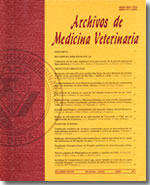Electrophoretic characterization for both normal and hard chorion proteins of Salmo salar
Main Article Content
Abstract
The chorion is an egg envelope that allows the early development of teleostean fishes. After reaching the alevin stage, hatching enzymes are secreted in order to digest the chorion and release the alevin. Massive mortality events have occurred in a number of salmon farms as a consequence of hatching problems, with alevins being unable to degrade the chorion. A previous study on the chorion structure of Salmo salar has shown that protein fibers forming the inner layer of non-degraded chorion are thicker than those observed in normal chorion, suggesting that polypeptides forming the choriogenin could exhibit an altered structure. It would be interesting to make a biochemical comparison between polypeptides forming protein fibers of the inner layer of normal and hard chorion in order to establish differences in the electrophoretic pattern of Salmo salar ova. According to our results, fibers forming the inner layer of normal chorion are thinner than those building the hard chorion. The electrophoretic pattern for normal chorion is described as four bands of molecular weight 107 kDa, 92 kDa, 38 kDa, and 31kDa in contrast to the 179 Kda, 157 Kda, 55 Kda and 54 Kda for non-hatched chorion. Consequently, protein fibers with higher molecular weight turned into thicker fibers with a different three dimensional structure, but also with different glycosylic radicals compared to normal fibers. These features make the inner layer of hard chorion different to normal chorion since it is very difficult for the hatching enzyme to dissolve it, leading the alevin to fail in the hatching process.

